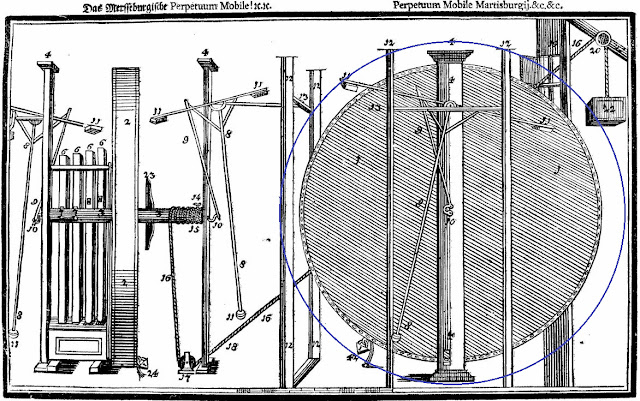In his Apologia Poetica, Bessler included many textual clues, some encoded and some merely ambiguously phrased so that getting the true meaning from each was a struggle. This one is puzzling and in my opinion, has led to a misunderstanding of what he meant, however in the following explanation I believe the meaning becomes clear.
He wrote, “a great craftsman would be he who can lightly cause a heavy weight to fly upwards, or as one pound falls a quarter, cause four pounds to shoot upwards, four quarters.” This seems on the face of it to be nonsense and yet by picking it apart one can get at the meaning.
Note that within the quote he mentions that there are five weights; i.e., one plus four, and each one is equal to one pound. Secondly, one pound falls a quarter. How do we define what he meant by a quarter? In this case he was referring to a clock and a quarter of an hour meant 90 degrees. How could this single fall cause “ four pounds to shoot upwards four quarters”?
It is very simple. In the first part above, the word ‘quarter’, referred to, not just 90 degrees but also to a clock. In the second part the word ‘quarter’ also refers to a clock but this time he has confused us by using the words ‘four quarters’. ‘Four quarter’s equals ‘one whole unit’. Each hour on a clock is divided into 30 degrees, so the words ‘four quarters’ meaning ‘one hour’ as used here equals thirty degrees. To paraphrase Bessler’s words, “a great craftsman would be he who, as one pound falls 90 degrees, causes each of the other four pounds to shoot upwards 30 degrees.”
You might think it would have been better to have said that when “one pound falls 90 degrees, it causes one pound to shoot upwards 30 degrees”, but that would have removed the information that five weights were involved, so it had to be four weights plus the one, and he liked to obfuscate otherwise it would have been too clear.
You might think it would have been better to have said that when “one pound falls 90 degrees, it causes one pound to shoot upwards 30 degrees”, but that would have removed the information that five weights were involved, so it had to be four weights plus the one, and he liked to obfuscate otherwise it would have been too clear.
When he suggested that this advice would be understood by a great craftsman, I think he meant that it was possible to grasp his meaning if you recognised that at first sight it was impossible, and therefore you would have the mechanical knowledge to realise it, and work out the real meaning, and he was also informing us that those two angles were an important ingredient in the mechanism. Such a strong mechanical advantage would certainly ‘shoot’ a weight upwards ‘lightly’.
PS - Some people think I have never published any clues, except those on www.theorffyreuscode.com but you may be surprised to learn that I published this interpretation in a blog dated 14th October 2011, and the clock in September 2016 and many others at other times. It’s amazing to think I published this interpretation almost ten years ago and I see people are still trying to make four pounds shoot upwards by causing one pound to fall the same distance! I’m beginning to wonder if it’s worth publishing any more until I’ve finished my wheel. Until you see the final design the clues are largely meaningless and I’m not going to publish any of the really useful ones until I’ve completed my own wheel! I apologise if this is disappointing, but I hope that it won’t be long before I finish the wheel and I can publish it all and await the reactions.
JC






